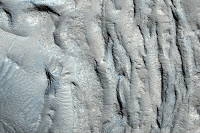
An
article on
Space.com reported today that the Mars Rovers have weathered two terrible winters on the surface of the Red Planet and a third one is coming soon. This poses a dilemma because these rovers were only supposed to be on a 90 day mission. The Martian winter will last from March 2008 to October 2008. Although Mars has a similar tilt to Earth, the seasons are longer because it takes the planet twice as long to orbit the Sun (687 Earth days).
Steve Squyres, principal scientist of the
Mars Exploration Rover team at Cornell University said,
"When you're talking about the rovers surviving winter on Mars, planning many months in the future is really important, but it's too soon to tell where we might situate them."
When the conditions are dim, the solar-powered robots take a real energy hit.
Squyres added, "The sun gets very low in the sky, giving us a lot less solar power to work with." Fewer gusts of wind are around to clean the dust from the solar panels on the rovers which makes the problem even worse.
Squyres also explained what they have done the past few winters,
"We try and park them on a broad, north-facing slope that helps them gather more sunlight. During the winter, it's essentially science on a hill. If we're stuck on a small slope, we're much more limited in what we can investigate."
However, this is not always a bad thing.
Squyres added that when the rover is stuck in one place, it allows them to intensively study a single small area. During the last winter,
Spirit studied a palm-sized area of soil for months. This is now probably the best-studied patch of dirt in the solar system outside of Earth. Even though the rovers have done far-and-above their call of duty, it is still impossible to predict the survival of these robots. The rovers have both lasted more than 1,324 Earth days beyond their warranty.
Squyres added to the uncertainty by saying,
"Their long lives are experiments in progress. They could die three years from now, or in the next hour. There's simply no way for us to know, so we're trying to do as much as we can with what time we might have left."














 http://www.marsdaily.com/reports/Opportunity_Second_Martian_Birthday_At_Cape_Verde_999.html
http://www.marsdaily.com/reports/Opportunity_Second_Martian_Birthday_At_Cape_Verde_999.html







